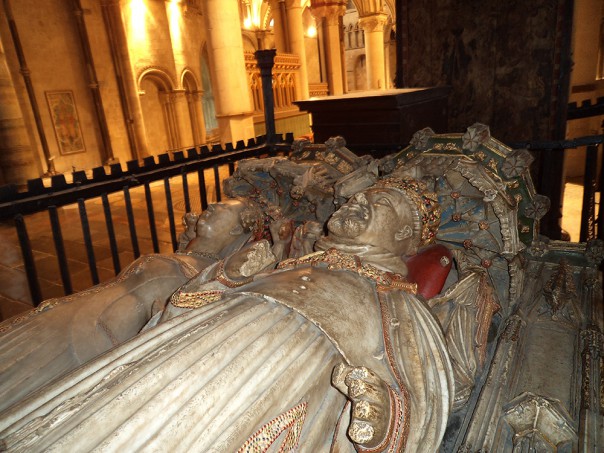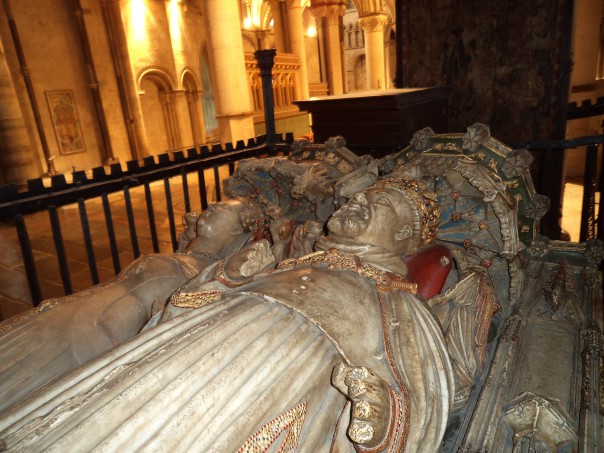Two nights ago I attended Dr David Grummitt’s lecture to Canterbury Historical and Archaeological Society at Canterbury Christ Church. The Society’s committee had decided to use the three autumn meetings for talks on this year’s great anniversaries, and the December meeting was the last of these on the Battle of Agincourt. As the head of the university’s School of Humanities and a late medieval/Tudor historian, Dr Grummitt is also involved in the Centre and on the committee organising the Medieval Canterbury Weekend. At the Weekend on Sunday he will be speaking on Henry VI, drawing on his very recent biography of the king, but on Wednesday he concentrated on the exploits of the father, Henry V.
To provide some background for his listeners, David Grummitt briefly sketched out the main events of the Hundred Years War during the fourteenth century and how by the last decade of Richard II’s reign there was a war-weariness on both sides which saw a halt to hostilities. Thus when Henry IV took the throne in 1399 there no appetite for foreign war and really the king had enough issues he needed to counter at home, including problems in Wales. This brought Dr Grummitt to his main subject, Henry V and his military exploits in France. He draw attention to Henry’s use of the quarrel with the French king to bolster Lancastrian legitimacy, portraying himself as the wronged king both on a personal level and as the English monarch.
In terms of the Agincourt campaign, he first noted the difficulties Henry encountered when he besieged Harfleur, especially the losses experienced through disease before Henry was able to take the town, an exploit widely celebrated in England. David Grummitt then went on to look at the actual Battle of Agincourt by exploring three questions: what size were the opposing armies; was it a

hivalric affair, and why were the English so successful. There isn’t space here to look at these as he was able to do, so I’ll just pick out a couple of points.
Firstly, Dr Grummitt discussed both the abundance of the chronicle evidence for the battle from both the English and French sides and how such sources have been interpreted by modern historians. Regarding the reliability of these sources for the relative size of the two armies, he discussed the work of Professor Anne Curry on the muster rolls in which she has questioned the chronicle accounts. Yet he made the point that he thinks there are problems with these rolls as they now stand in The National Archives because they have been arranged by nineteenth-century archivists rather than being as they were in the fifteenth century, consequently he sets more store on the chronicles than Professor Curry regarding their emphasis on the disparity in size between the two armies.
However whatever the precise numbers, Dr Grummitt was keen to highlight Henry V’s capabilities as a commander: his willingness to listen to his seasoned lieutenants such as Sir Thomas Ermingham and his leadership qualities with regard to his men, and most particularly the core group of knights around Henry himself. Dr Grummitt felt Shakespeare was able to bring this out and to illustrate the point he played the audience a couple of film clips of probably the two most famous speeches – I leave you to decide which they were! Moreover in terms of the outcome of the battle, Dr Grummitt drew attention to several blunders by the French throughout the course of the battle, but he highlighted that probably within the melee there was a crucial twenty-minute period that decided the outcome.
When examining the battle’s legacy, David Grummitt underlined how disastrous it was for the French, as well as discussing how initially it greatly enhanced the English, especially the Lancastrian position. However the death of Henry V and then his father-in-law the French king set in train what would become an increasingly untenable dual monarchy, the situation made exceptionally difficult by the problems of an infant king, a long minority and often profound differences among the young king’s uncles. And it was this aspect that prompted several of the questions that followed the conclusion of his excellent lecture. Indeed the number of questions would indicate the audience’s interest and enjoyment, and as I left I saw several others had gone to talk to him further.
This would suggest that the Medieval Canterbury Weekend committee was right to include several lectures on military history, as well as David Grummitt’s own talk on Henry VI. Among these lectures during the Weekend are Gordon Corrigan’s on the Hundred Years War and Michael Jones’ on the Black Prince. Both sound interesting, but the Black Prince is especially appropriate for Canterbury on account of his tomb in the cathedral. Moreover, of course, the cathedral is also the last resting place of Henry IV – as you can see above. And finally thinking about such Canterbury connections, Henry V came on pilgrimage to Canterbury soon after Agincourt, and then again the following year in 1416 when he was accompanied by Emperor Sigismund.
 Centre for Kent History and Heritage
Centre for Kent History and Heritage Matthew Crockatt
Matthew Crockatt 1414
1414


